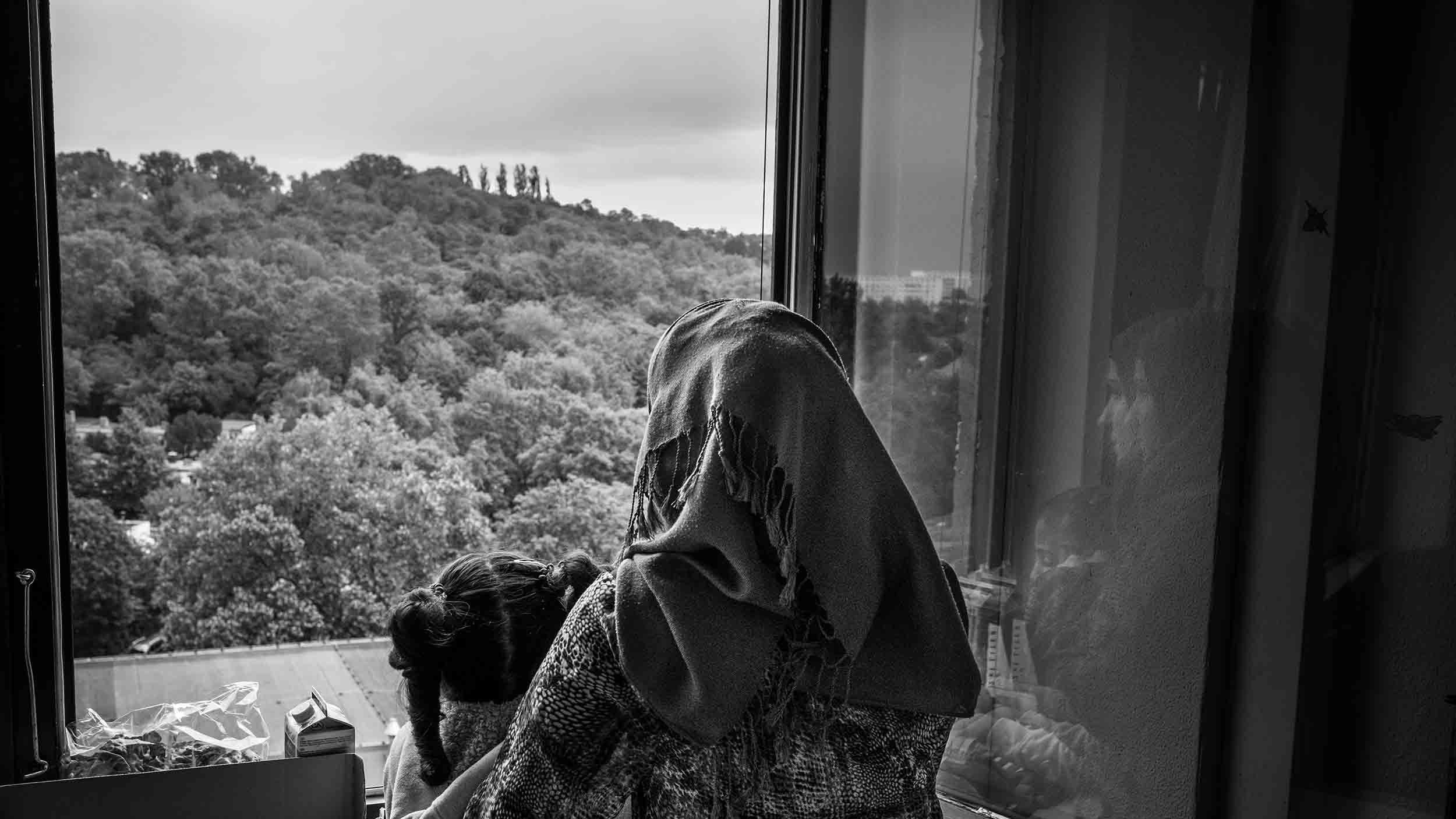Refugee Girls Want to Change the World. Will We Let Them?
Although cultural tides are shifting, a lack of educational resources and opportunities makes it hard for girls to reach their potential.

This story about refugee education was produced in partnership with The Hechinger Report, a nonprofit, independent news organization focused on inequality and innovation in education.
A sea of 76 students in bright violet uniforms with pointed white collars confronted Jessica Deng as she stepped into her classroom. The students—all girls in the eighth grade—crowded around worn wooden desks and battered textbooks as she briskly set them to work on a math problem. The equatorial sun had begun to heat up the September day and burned through the curtainless windows of Deng’s classroom at Bahr El Naam Primary School, a compound of dusty one-story cement rooms lacking air conditioning and electricity in the Kakuma Refugee Camp in Northern Kenya.
Deng is just 21; her students are only a few years younger. Standing tall in a black T-shirt and gray slacks, a braided bun on top of her head, she carries a red pen as she walks up and down the aisles. The girls watch her pass with eager eyes and wave their notebooks for her to correct.
Some want to be lawyers or doctors. One wants to be a pilot. For most, the obstacles that stand in the way of achieving these ambitions are insurmountable.
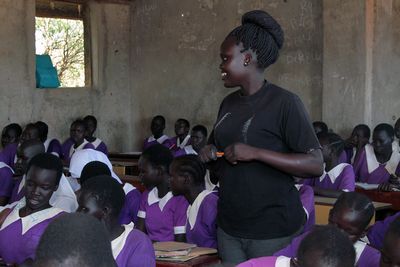
Jessica Deng, 21, teaches a math class at Bahr El Naam Primary School, an all-girls school in Kakuma Refugee camp.
Deng herself wonders if she will reach her goals. She wants to go to college to study public health. She’s applied for a scholarship to a university in Canada. But it’s highly competitive; she’s already been rejected. Twice.
“My students, myself, every other girl or woman that is in the camp, if all of us were given the opportunity to get quality educations somewhere else, we would lead better lives,” Deng says. “We would go back to our homelands and change some things.”
These young, resilient girls are an untapped resource. But they’re at risk of being indirect casualties of entrenched conflicts, their potential squandered in underfunded schools and wasted by lack of opportunity.
Get exclusive access to fashion and beauty trends, hot-off-the-press celebrity news, and more.
“If all of us were given the opportunity to get quality educations, we would go back to our homelands and change some things.”
For now, Deng and her students are stuck—along with 185,000 other refugees—in Kakuma. It’s a purgatory where most people depend on the subsistence rations passed out by the U.N. for survival. They're barred from working outside the camp and must search for jobs within the small economy that has sprung up—running makeshift shops selling soda or shoes or working for aid organizations.
Career options are limited, and so are chances to leave. Kakuma’s refugees were driven from their homes in countries like Somalia, Ethiopia, or South Sudan by war or famine. Going home is seldom a realistic option. Resettlement in another country is a long and difficult process that less than 1 percent of refugees ever achieve.
The United States resettles more refugees than any other country, but the number allowed in has been decreasing steadily since President Trump took office. In 2016, the United States welcomed 84,994 refugees, just six shy of its cap. In September, the Trump Administration proposed lowering the cap to 30,000.
The administration has defended the reductions in part by arguing that refugees don’t want to come to the United States; they want to go home. That’s not entirely wrong. None of the refugees I meet during a week reporting in Kakuma mention coming to the United States. Many talk instead about returning home and working to rebuild once violence subsides.
But when I ask what they wish outsiders knew about their lives, most say they want people to understand that Kakuma is an exceptionally tough place to live. They stay only because they have no other options. Many students get upset talking about their education, frustration showing on their faces. They don’t want much: A light so they can study at night. Smaller classes. Access to computers.
“More than 50 percent are not living how they wanted to live,” Deng says of her students. “They want to get out.”
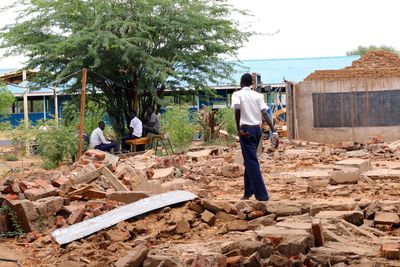
A student walks over the remnants of Kakuma Refugee Secondary School’s old mudbrick buildings.
One day I see a girl unconscious—she fainted during a break between classes. The school doesn’t have a nurse. Instead, the girl’s friends carry her into a space between two buildings seeking room and shade. They gather around, fretting and shaking her. The scene escapes the notice of most students and teachers. The teacher I’m talking to checks in and tells me the girl has been fainting regularly lately, but she’ll wake up. There’s nothing else to be done.
The harsh reality here contributes to low school enrollment, particularly among girls, that only gets worse as they get older. Forty percent of primary school students in Kakuma are girls, but they make up less than a quarter of all secondary school enrollments. That’s despite research that shows educating girls leads to a drop in child marriage and child mortality rates and an increase in female earnings.
In the camp and elsewhere, agencies work to change cultural beliefs that girls don’t need to be educated or should be married off as teens to the highest bidder. Programs have begun to make progress increasing female retention in school, but a lack of resources makes it hard for these girls to capitalize on the slowly shifting attitudes.
The girl has been fainting regularly lately, but she’ll wake up. There’s nothing else to be done.
Nearly 20 million refugees live under the United Nations High Commission for Refugees (UNHCR) mandate, more than half of whom are under the age of 18. More than a third of those children and teens don’t attend school. When they do, the schools are chronically underfunded. Windle Trust Kenya, the nonprofit that runs Kakuma’s secondary schools in partnership with UNHCR, lacks the money to do more than triage. It spends just $153 per pupil. (By comparison, per pupil sending in the United States tops $11,000.) That’s not enough money to reduce class sizes that frequently surpass 100, or make sure every student has access to textbooks.
Young women here, like Deng and her students, know full well the obstacles they face. And yet they get up each morning and make the trek to school on foot, each hoping they might be the one to get out. “It sometimes breaks our hearts that you’ve trained them, but at the end of the day they’re still in the camp,” says Kakuma’s Greenlight Secondary School Principal Robert Bett. “Their lives haven’t changed.”
In 1991, Kakuma was just a small town in a barren part of Kenya. The camp was established as a UNHCR location in 1992 when thousands of refugees—including the orphaned Lost Boys of Sudan—began arriving. Soon, more refugees poured in from Ethiopia, Somalia, and Sudan. By 2014, Kakuma was 58,000 people over capacity and the UN created a new settlement just north to accommodate those continuing to flee.
Deng’s parents were among those who came to Kakuma to escape the civil war in Sudan. They don’t tell Deng much about what drove them from their home, and she doesn’t ask. When they arrived in 1992, refugees were creating a makeshift city of tarp and mudbrick homes with dirt floors. These small dwellings covered a landscape previously dotted with the one thorny tree stubborn enough to grow in the cruel conditions.
Deng was born at the camp in 1997. In some ways, growing up in the camp—surrounded by a variety of cultures as well as fellow South Sudanese refugees—was exciting. “But at the same time, it was not easy,” she says. “I didn’t get everything I should have gotten as a child.”
Refugees rely on UN disbursements for most of their food—they eat the same thing over and over again and there isn’t always enough to go around. On each block, there’s one water tap where people line up daily, holding empty jerry cans to fill.

Marie Jeserine is in her third year at Kakuma Refugee Secondary School. She walks 50 minutes each day to get to campus.
Most days, the sun is hot and unforgiving. But when the rain comes, it often floods the camp and washes away homes. It happened to Deng’s family “all the time” when she was younger, before they were able to move to higher ground, she says. “We’d have to come back again and build it again because there’s no where we can go.”
She attended primary school at Bahr El Naam, the same all-girls school where she currently teaches. She sometimes had a hard time paying attention in the overcrowded classrooms. The din of dozens of students packed in the room meant she sometimes “couldn’t even hear what teachers were saying.”
Although the physical conditions of Bahr El Naam have improved since Deng was a student—better buildings, more trees—many of the problems remain. The UN aims to have a 40:1 student-to-teacher ratio in its refugee schools. In Kakuma, there are more than 95 students for each teacher. I visit one classroom that has more than 200 students, leaving the teacher only a few square feet in which to stand. There aren’t enough textbooks or desks; students in the early grades must sit on the floor.
About 85 percent of teachers are refugees themselves, most of whom have gone to school at the camp and many of whom begin teaching without any formal training. The only qualification necessary is a high school degree.
I visit one classroom that has more than 200 students, leaving the teacher only a few square feet in which to stand.
Deng fell into teaching without any real enthusiasm shortly after finishing secondary school. She wanted a job and there were few other options. She earns about $74 a month.
At first, she struggled to manage her students. But then she signed up for a training program called Teachers for Teachers. (Disclaimer: Teachers for Teachers is run by Teachers College, Columbia University. The Hechinger Report is an independent unit based at Teachers College.) The program taught her how to control her classroom and keep her students’ attention. It also helped her grow to love teaching. “When a girl understands mathematics—and I had trouble getting maths in school—but when I teach and somebody understands, it feels nice,” she tells me.
Deng’s family was able to pull together enough money from relatives to send her to a boarding school in the country’s capital, Nairobi. (In Kenya, boarding schools generally offer the highest quality education.) Deng recalls her mother saying, “I’m not educated, but if I was, we wouldn’t be living like this. So it’s your turn to be educated and not live like this.”
Many men in the community scoffed at the idea that Deng would go away for high school, telling her that girls were stupid and she would drop out. Deng was tempted, as she struggled with subjects like chemistry and geography and the intense pressure to do well on tests. One time, she failed an exam badly, despite studying hard, and came to her teacher crying. “I wanted to go home,” she recalls. “I told her I was very discouraged…I rather would stay at home than get such results.” Her teacher talked her down.
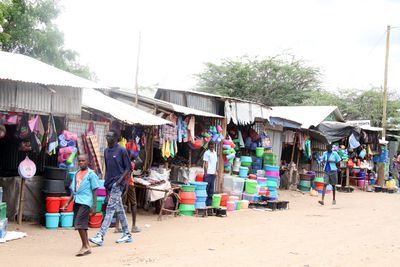
Refugees are legally barred from most work in Kenya, but being a store owner in one of Kakuma's marketplaces is one way they can make some money.
She never forgot the naysayers. “It was my drive,” she says. “It’s what made me actually complete my secondary school…I did it for myself, but I also wanted to prove others wrong.”
Looking back, Deng says her parents were right to send her away, even if it meant only going home once in four years. “They knew what I would turn out to be if I continued learning in the refugee camp,” she says. “I would not be who I am right now.” Leaving Kakuma for high school, “gave me the opportunity to realize who I was and what I could do, other than just being a refugee.”
Had Deng not gone to boarding school, she likely would have attended Kakuma Refugee Secondary School. Opened in 1992, it’s the oldest of the secondary schools at the camp and enrolls more than 3,000 students. Because of space issues, one group of students comes in the morning and the other comes in the afternoon.
The five secondary day schools in Kakuma face many of the same problems as primary schools. The classrooms are overcrowded; students sit four or five across at desks designed for three. They share textbooks among as many as eight other pupils. Schools don’t have the money to do all the science labs in the curriculum.
I did it for myself, but I also wanted to prove others wrong.
Marie Jeserine, a 20-year-old in her third year of high school, has other gripes. She wants a bigger library and more latrines (the school has 18 right now for 3,000 students, although an additional 16 are under construction). She’d also like school buses. Jeserine walks 50 minutes to get to school. By the time she arrives, she’s already tired.
She says her father sometimes tells her to just stay home: “Since you will stay here in the camp, you have gained nothing so you should not go to school.”
Like Deng, Jeserine was born in Kakuma and struggles to remain hopeful about life after high school. It’s helpful to meet with the school counselor. “She tells me not to give up, that there are many things in the future waiting for me,” Jeserine says. Attending university is one of them, she hopes.
The year before Deng graduated high school, a new option opened up right along the edge of the camp: the Morneau Shepell Secondary School for Girls, the first refugee boarding school in the world. Now, a relatively small group of girls (352) benefit from the most intensive intervention to improve female education at the camp.
Martha John Korok, 19, is one of them. She’s among the thousands of South Sudanese driven from their homes in the last decade. Her family first tried to outrun the violence without leaving the country, moving from place to place. But Korok remembers the gunshots each night. In South Sudan, “you can’t spend a night without bullet,” she says.
Her family heard about a safe haven in Kenya, and in February 2013, they fled on UN transport to Kakuma with nothing but a few possessions.
“I thought maybe they were keeping cattle. It was all about human beings.”
Korok thought the camp would be like a real city, fully developed with “lights all around.” Instead, she saw single-room shacks, dust, and fences. There were fences everywhere. “I thought maybe they were keeping cattle,” she says. “It was all about human beings.”
She enrolled in primary school, where she watched many of her female classmates drop out. She had to ignore the boys who felt threatened by her and told her a girl couldn’t do well academically. “You’re not supposed to be higher than them,” she explains.
In September 2013, her father unexpectedly passed away, after seeking help for a headache. Korok blames the health care providers. Her uncles back in South Sudan tried to convince the family to return so they could arrange a marriage for her. Her mother ignored them and the uncles stopped sending her family money.
The whole ordeal strengthened Korok’s resolve to do well in school. She had a new dream: She would become a doctor and prevent what happened to her dad from happening to others. So when she got the chance to attend Morneau Shepell, she took it.

Martha John Korok hopes the advantages Morneau Shepell has over the day schools in the camp will help her with her dream of becoming a doctor.
Girls who perform well enough on their exit exam from primary school are invited to apply. From there, school officials work with the UNHCR to determine which girls need protection the most—which ones are at risk for forced marriage or violence, are in single parent homes, or are orphans. For the 2018 school year, there were 1,000 applications for 90 spots.
Principal Irene Kinyanjui says that every morning at the start of a new term as many as 20 girls show up asking to be enrolled. A self-proclaimed “polite notice” on the deputy principal’s door announces “there are no vacancies in all the classes.”
At Morneau Shepell, the girls live in an educational oasis set away from the chaos of camp. They don’t have to worry about assault on the walk to school. They have electricity (unless it’s too cloudy for the solar power to work well). The classes are relatively small (around 40 students each) and are full of laughter.
When classes finish, students meander in groups to their dormitories to change from their plaid skirts and teal T-shirts into colorful sundresses. They gather in the dining hall on weekends to hold dance parties or watch movies on the school’s small flat screen television. Some girls are married; their husbands can come to visit, but the girls can’t leave campus during term.
For the 2018 school year, there were 1,000 applications for 90 spots.
Morneau Shepell, the Canadian-based human resource company that funds the program, opened the school after learning about the barriers girls face. In 2016, the firm pledged more than $1 million over five years to the school, which costs $700 per pupil to run each year, including teacher salaries, dorm supplies, and security.
Korok remains grateful that Morneau Shepell has provided her with a refuge within the camp and allowed her to focus on school, giving her a chance at a future. A future that she, like Deng, has pinned on Canada.
In Kakuma, going to Canada is the holy grail of post-secondary plans. Girls at Morneau Shepell have a shot at a scholarship to the University of Toronto. They must meet minimum requirements on the end-of-high-school exam and go through an interview, although not everyone who qualifies gets in. Last year, fewer than 10 of Morneau Shepell’s 70 graduates earned a spot at the university.
Still, their odds are better than those students from other Kakuma secondary schools, who must try for a scholarship run by the World University Service of Canada (WUSC). It allows refugees living in five countries, including Kenya, to resettle and attend a university in Canada. This is the scholarship Deng has applied for three times.
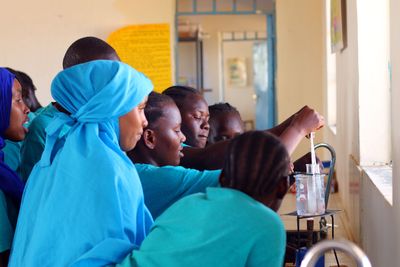
Students at Morneau Shepell Secondary School for Girls crowd around a Bunsen burner during a chemistry lab.
In 2017, more than 2,000 students from the five countries applied for 130 spots. Student visas are almost impossible for refugees to get, so this opportunity is one of best options students have to get out Kakuma and continue their education.
While waiting for word on her application, Deng teaches classes to primary school girls on sexual assault prevention. She works on an online diploma course through Regis University, one of 10 schools that the camp has partnered with to offer higher education. She also waits to hear about two other scholarships at universities in Kenya.
Deng tries to keep her expectations about the Canadian scholarship low to avoid the devastation she felt when rejected the previous two times. She’s even thought about going to South Sudan despite the dangers there.
Then, in September, after weeks of waiting, the news finally arrives: Deng gets a text message telling her she’s secured a scholarship to Canada. She’s one of 31 applicants from Kakuma, and 124 refugees overall—a majority of whom are girls—selected to begin classes in 2019.
Deng is so happy, she cries for the first 20 minutes after reading the news. “I knew that I could do this,” she says. “That I deserved it.”
For more celebrity news, beauty and fashion advice, savvy political commentary, and fascinating features, sign up for the Marie Claire newsletter.
RELATED STORY
